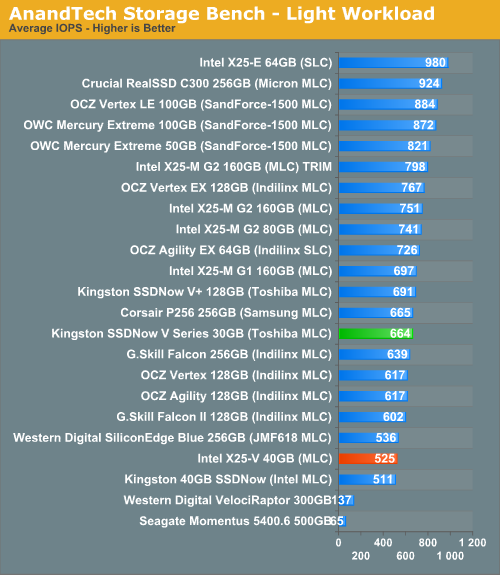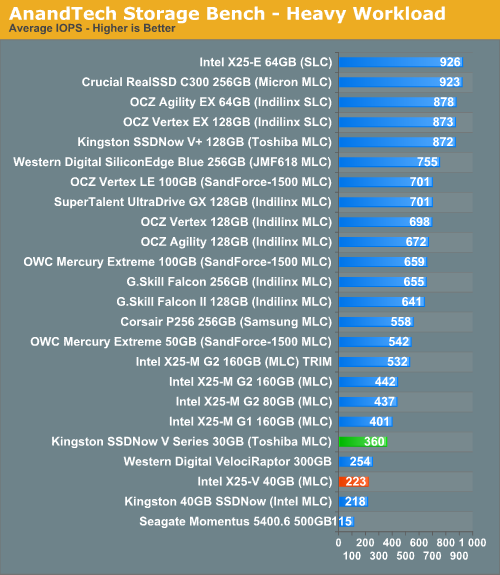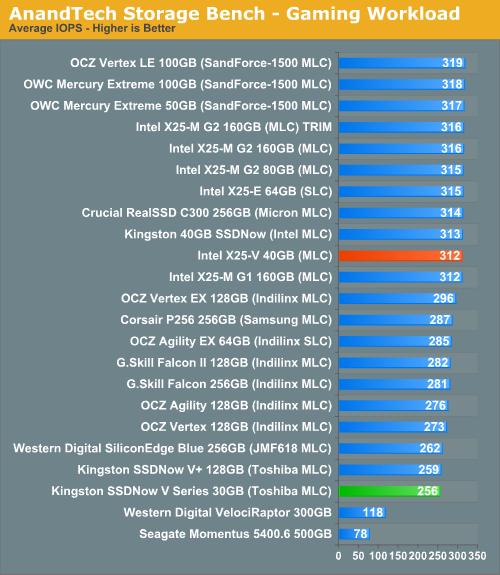Intel's X25-V & Kingston's 30GB SSDNow V Series: Battle of the $125 SSDs
by Anand Lal Shimpi on March 19, 2010 12:00 AM EST- Posted in
- Storage
AnandTech Storage Bench
Note that our 6Gbps controller driver isn't supported by our custom storage bench here, so the C300 results are only offered in 3Gbps mode.
The first in our benchmark suite is a light usage case. The Windows 7 system is loaded with Firefox, Office 2007 and Adobe Reader among other applications. With Firefox we browse web pages like Facebook, AnandTech, Digg and other sites. Outlook is also running and we use it to check emails, create and send a message with a PDF attachment. Adobe Reader is used to view some PDFs. Excel 2007 is used to create a spreadsheet, graphs and save the document. The same goes for Word 2007. We open and step through a presentation in PowerPoint 2007 received as an email attachment before saving it to the desktop. Finally we watch a bit of a Firefly episode in Windows Media Player 11.
There’s some level of multitasking going on here but it’s not unreasonable by any means. Generally the application tasks proceed linearly, with the exception of things like web browsing which may happen in between one of the other tasks.
The recording is played back on all of our drives here today. Remember that we’re isolating disk performance, all we’re doing is playing back every single disk access that happened in that ~5 minute period of usage. The light workload is composed of 37,501 reads and 20,268 writes. Over 30% of the IOs are 4KB, 11% are 16KB, 22% are 32KB and approximately 13% are 64KB in size. Less than 30% of the operations are absolutely sequential in nature. Average queue depth is 6.09 IOs.
The performance results are reported in average I/O Operations per Second (IOPS):

Intel's X25-V performs virtually identically to the older Kingston 40GB Boot Drive. The new 30GB drive does have the advantage though, performing much more like an Indilinx drive than a scaled down X25-M thanks to its higher sequential write speed.
If there’s a light usage case there’s bound to be a heavy one. In this test we have Microsoft Security Essentials running in the background with real time virus scanning enabled. We also perform a quick scan in the middle of the test. Firefox, Outlook, Excel, Word and Powerpoint are all used the same as they were in the light test. We add Photoshop CS4 to the mix, opening a bunch of 12MP images, editing them, then saving them as highly compressed JPGs for web publishing. Windows 7’s picture viewer is used to view a bunch of pictures on the hard drive. We use 7-zip to create and extract .7z archives. Downloading is also prominently featured in our heavy test; we download large files from the Internet during portions of the benchmark, as well as use uTorrent to grab a couple of torrents. Some of the applications in use are installed during the benchmark, Windows updates are also installed. Towards the end of the test we launch World of Warcraft, play for a few minutes, then delete the folder. This test also takes into account all of the disk accesses that happen while the OS is booting.
The benchmark is 22 minutes long and it consists of 128,895 read operations and 72,411 write operations. Roughly 44% of all IOs were sequential. Approximately 30% of all accesses were 4KB in size, 12% were 16KB in size, 14% were 32KB and 20% were 64KB. Average queue depth was 3.59.

Crank up the sequential writes and Kingston's lead grows. The 30GB V series drive almost performs like an X25-M G1 in this case. The X25-V on the other hand performs more like a low latency VelociRaptor. Still better than a hard drive, but don't expect to copy files any faster.
The gaming workload is made up of 75,206 read operations and only 4,592 write operations. Only 20% of the accesses are 4KB in size, nearly 40% are 64KB and 20% are 32KB. A whopping 69% of the IOs are sequential, meaning this is predominantly a sequential read benchmark. The average queue depth is 7.76 IOs.

With both Intel and Kingston equal in sequential read performance, the differentiating factor here is strictly random read performance where the X25-V has the edge.










78 Comments
View All Comments
samspqr - Monday, March 22, 2010 - link
I agree with your posts on the other thread: I don't care about IOPS, just like getting more points in a benchmark won't make me happy by itselfI'm totally in the dark with respect to SSDs so far; with things as they are now, I guess I'll have to wait till I get my hands on one of them and can do my own testing (general feeling, then 3D rendering, video editing and encoding)
Taft12 - Saturday, March 20, 2010 - link
Rendering performance is not really an important bechnchmark for a general desktop computing website such as this.samspqr - Monday, March 22, 2010 - link
well, if it is in the CPU reviews, then it could be here too, coudn't it? at least if they found out that there's some difference, which is why I'm askingsamspqr - Friday, March 19, 2010 - link
here it is:http://www.3dprofessor.org/Reviews%20Folder%20Page...">http://www.3dprofessor.org/Reviews%20Folder%20Page...
they halved the rendering times by moving from a Western Digital 1TB RE-2 to a velociraptor, on a dual QX9775 board
soltari - Friday, March 19, 2010 - link
The kingston (intel) 40gb bootdrive was an awesome drive while it lasted. Mine actually did arrive last december with trim firmware on it, to my pleasant surprise. However after it died after purring along for 10 days and faced with no replacement possibility due to intel now wanting to sell only their identical more expensive drives i had to get a new one and for sure wasnt going to pay 35 dollars more to get the same drive back. An OCZ vertex 60gb is doing the purring now without issues.still the small SSD drive to run your O.S. from is an amazing improvement to overall performance. For this these new small cheap drives are great.
davepermen - Friday, March 19, 2010 - link
I use the X25-V in a Media Center setup (all actual data over the (gb) network). the -V delivers absolutely stunning performance, resulting in a fast to boot, very snappy system. and it has enough spare space for recording tv before it gets shifted to the winhome server.i could never get the kingston solution when seeing it's random performances. it's imho the main thing that makes an ssd feel fast. the media center is always "there", always "reacting". and even while the 40MB/s write speed is slow, the fact that it delivers nearly constant 40MB/s no matter if it's sequencial or random does it still perform quite fast (faster than hdds) in most real life cases (like installing the os).
i'm happy to get 10GB more space for the same price (a big thing in such low-storage devices), and i'm happy to get the overall more snappy and responsive performance.
for me, it's Intel: 1, Kingston: 0.
Shadowmaster625 - Wednesday, March 24, 2010 - link
Just like anand, here is another example of mindless intel worship.1. They arent the same price. One is 30% cheaper.
2. For media center applications, either would work perfectly fine, so obviously you dont know what you're talking about.
dagamer34 - Friday, March 19, 2010 - link
So definite improvement when using an SSD in media center? I've been meaning to get one, but didn't think that my primary apps could fit in 40GB. Seems a bit small.buzznut - Monday, March 22, 2010 - link
It depends on your install. You can easily get a win7 installation down to 10 gigs by turning things off like system restore, page file, and hibernation.I use the 40GB Intel drive and have Win7 pro, Office, flash, and any number of small productivity apps plus Heroes V with all the expansions. 15GB free atm, plenty of room to add PowerDVD and whatnot.
kmmatney - Friday, March 19, 2010 - link
" You gain better sequential performance and concurrent IOPS, but you have no way to actively curb performance degradation. "Can you schedule the SSD Toolbox to perform a manual TRIM. WOuldn't be so bad then - set it to run once a week and forget about it.
I have to say, Intel wins this round, easily. The Kingston would have had to perform much better to make up for the smaller drive size. I would expect that the Kingston will have to come down in price to remain competitive.